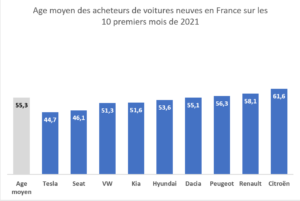The over-50s, and in particular the Baby Boomers, have grown up with the development of the car in French society. Their history and current needs mean that they remain very attached to them and this is reflected in the high age of new car buyers.
According to Autoways, in 2021, the average age of new car buyers is 55.3 years. One in two buyers is therefore a senior citizen. French and traditional brands have the highest average age:

Within the brands, there are significant differences depending on the model. At Audi, the average age of an A8 buyer is 68, while that of an A1 buyer is 48. Conversely, at Peugeot, the average buyer of the 108, a small car, is 62 years old, while the average buyer of the 5008, a more family-oriented model, is 50.
There are several reasons for the trend towards a decline in the age of new car buyers:
- the growing weight of the 55+ in the population, they will represent 42% of adults in 2020,
- the higher standard of living of 50-64 years old, the highest level among people over 18 years of age with €24,450 per year (i.e. 11% more than the average in 2019)
- but also their history.
In 1973, when most Baby Boomers came of age (21 at the time), only 50% of the adult population had a B licence and only 60.7% of households had a car; in 2018, 80.4% of households have one. It is the Baby Boomers who have profoundly benefited from this change. Obtaining a driving licence marked the entry into the adult world and buying a car with one’s first salary was an aspiration. For this generation, buying a car was a symbol of social success. Among the Baby Boomers, it was mainly women who experienced a profound change compared to previous generations. In 1981, only one in two adult women had a driving licence, whereas three quarters of men had one. Among female Baby Boomers, the situation has changed with women holding as many licences as men.
In 2018, households aged 40-59 have the highest level of car ownership with 88.9% owning one and 45.9% owning two. Over the age of 60, with a majority of drivers from the Baby Boom generation, this rate drops to 80.6% for the ownership of one car, but it is above all the ownership of a second car that drops sharply with 26.8% of households concerned; retirement often leads to the abandonment of the second car.
Sources: Autoways 2021, Insee 2020; Des mobilités plus homogènes ou plus diversifiées Robert Grimal 2012, Insee SRCV 2018; Insee enquêtes Revenus fiscaux et sociaux 2005 à 2019.




